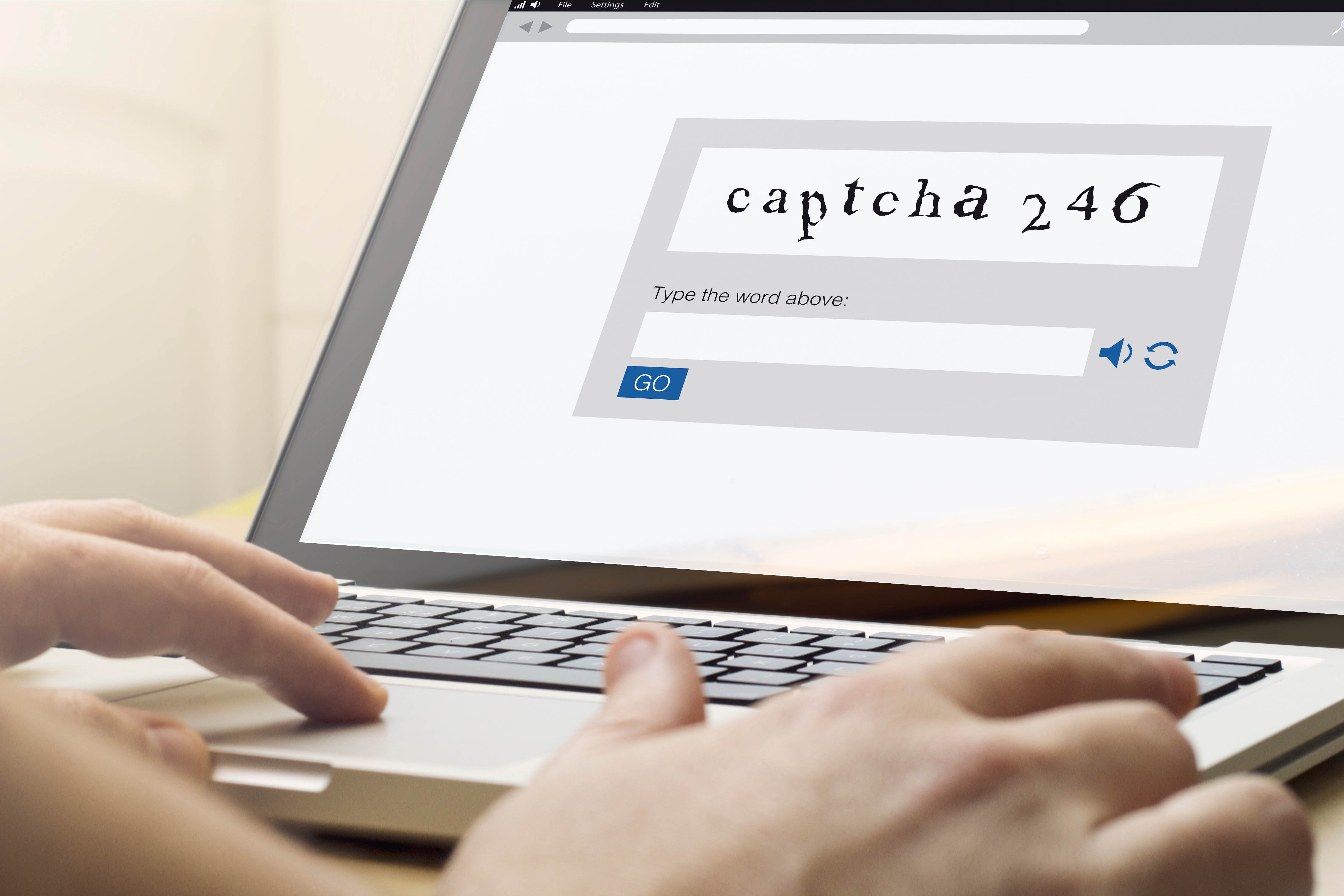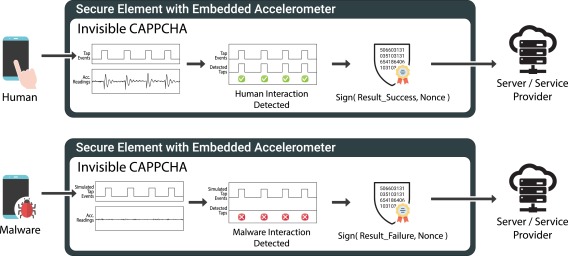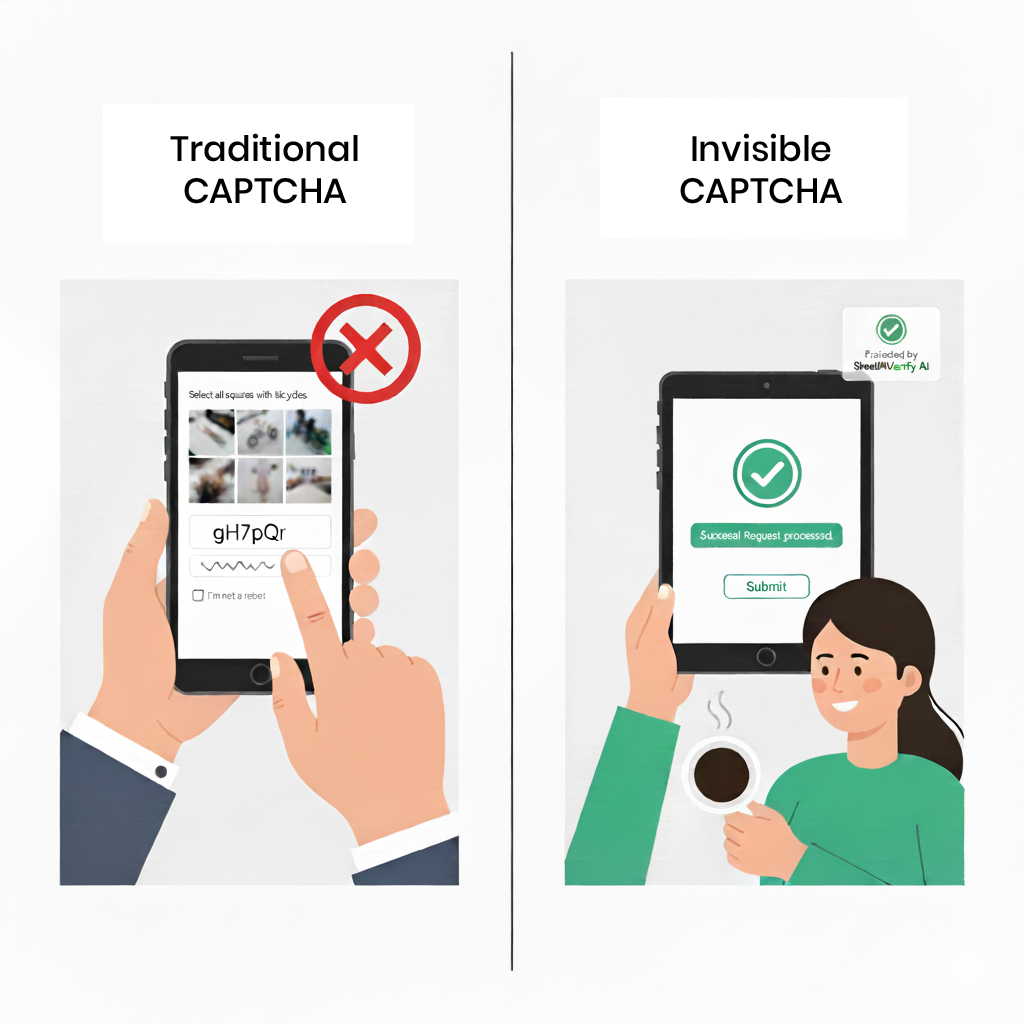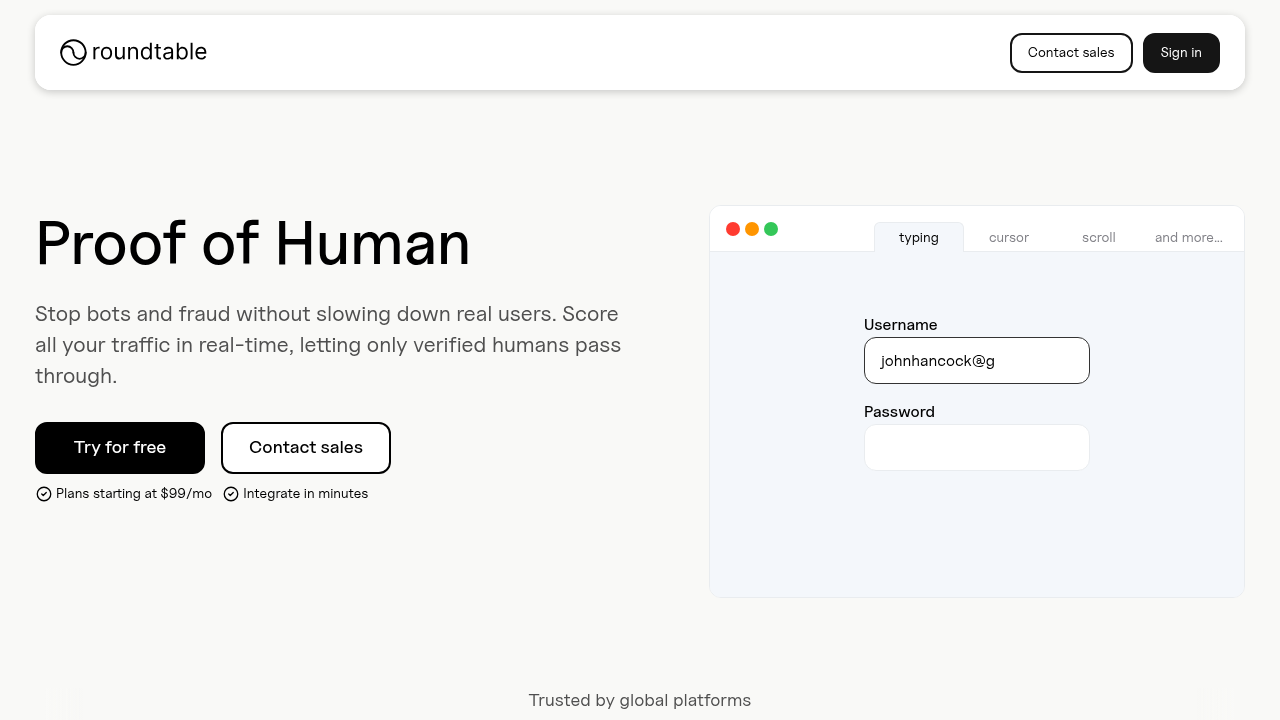10/10/2025. We've all been there: squinting at distorted text or clicking on images with traffic lights while a website decides if we're human enough to proceed. The good news is that there's a better CAPTCHA experience where you don't have to sacrifice the user experience to keep your website secure:
invisible CAPTCHA. Protecting your site or web application from bots and bad actors can now happen entirely behind the scenes.
TLDR:
- Invisible CAPTCHA analyzes behavioral patterns like mouse movements and typing rhythms to verify humans without user friction
- Traditional CAPTCHAs waste 32 seconds per user and cause 15-30% abandonment rates
- Behavioral biometric analysis looks at cognitive patterns that are economically difficult for bots to replicate
- You can deploy invisible protection with a single line of code while maintaining full privacy compliance
What is Invisible CAPTCHA?
Just like regular CAPTCHA, invisible CAPTCHA is a system to determine the authenticity of a website visitor. While regular CAPTCHA presents users with things to do, like copying a random string of characters, invisible CAPTCHA works behind the scenes. When a user visits a website protected by this technology, it monitors their behavior by analyzing various factors, such as mouse movements, keyboard inputs, and navigation patterns. By assessing these elements, it determines whether the user is human or a bot. If the user is a bot, the system may present some additional security measures like those found in regular CAPTCHA solutions.
Modern invisible CAPTCHA systems check dozens of behavioral signals at the same time. They track cursor movements, scroll patterns, click timing, and even how users interact with form fields. This detailed behavioral analysis happens in milliseconds, allowing legitimate users to proceed without interruption while flagging suspicious automated activity.
The evolution from visible to invisible CAPTCHA reflects a growing understanding that security shouldn't come at the expense of user experience. And, the sophistication of these systems continues advancing as bot creators develop more sophisticated attack methods.
How Invisible CAPTCHA Works
The mechanics behind invisible CAPTCHA systems involve sophisticated real-time analysis of user interactions. These systems collect and process behavioral data including browser configurations, mouse movements, keystroke patterns, scroll behavior, and interaction timing to build a complete picture of user authenticity.
When a user visits a protected website, the invisible CAPTCHA begins monitoring their behavior immediately. It tracks micro-movements in the cursor path, noting the natural tremor and slight irregularities that characterize human motor control. Bots typically move cursors in perfectly straight lines or teleport between positions, creating detectable signatures.
Keystroke dynamics provide another rich source of behavioral data. Humans type with natural variations in timing between keystrokes, brief pauses for thought, and subtle rhythm patterns unique to each individual. Automated systems struggle to replicate these irregularities convincingly.
Invisible CAPTCHA technology also analyzes broader interaction patterns like how a user moves between form fields, scrolling behavior, and even how long they spend reading content before taking action.
Invisible CAPTCHA systems process dozens of behavioral signals in real-time, creating a complete behavioral fingerprint that distinguishes human cognitive patterns from automated scripts.
These behavioral signals combine to create a risk score that determines whether additional verification is needed. This smooth operation shows the core value proposition of invisible CAPTCHA technology: maintaining security without sacrificing user experience.
Research also shows how behavioral analysis provides a stronger foundation for distinguishing authentic users from automated threats. More advanced invisible CAPTCHA systems even use machine learning models trained on millions of human and bot interactions to continuously improve detection accuracy. This allows them to adapt to new bot techniques while maintaining low false positive rates for legitimate users.
Invisible CAPTCHA vs Traditional CAPTCHA
Traditional CAPTCHA systems create major friction in the user experience by requiring active participation in challenge-response interactions. Users have to decipher distorted text, identify objects in images, or solve puzzles before accessing content or completing transactions.
This friction comes with real costs. Studies show users spend an average of
32 seconds completing traditional CAPTCHA challenges, and
15-30% abandon their intended actions entirely when faced with difficult or repeated challenges. The
accessibility issues are even more severe, as visually impaired users often couldn't complete visual challenges at all.
| Feature |
Traditional CAPTCHA |
Invisible CAPTCHA |
| User Interaction |
Required challenges |
No interaction needed |
| Completion Time |
10-35 seconds |
Instant |
| Accessibility |
Poor for disabled users |
Fully accessible |
| Bot Detection Rate |
60-70% |
80-90%+ |
| User Abandonment |
15-30% |
<5% |
Traditional CAPTCHAs are also increasingly vulnerable to AI. When bots are combined with modern image recognition and text processing features of AI, they are able to solve many traditional challenges more accurately than humans can.
Invisible CAPTCHA systems eliminate these friction points while providing superior security effectiveness. Users can complete their intended actions without interruption, leading to higher conversion rates and better overall user satisfaction.
A Note About Privacy
Traditional CAPTCHA and invisible CAPTCHA also differ greatly in their approach to privacy. Because invisible CAPTCHA tracks and analyzes user behavior, it captures and stores extensive user data. Using invisible CAPTCHA then may require additional disclosures to remain compliant with privacy regulations like GDPR.
Understanding And Measuring Invisible CAPTCHA Effectiveness
The real-world effectiveness of invisible CAPTCHA systems varies greatly based on their implementation and the sophistication of the threats they face. While these systems generally outperform traditional CAPTCHAs in detection accuracy, they face unique challenges from advanced bot operators.
One major vulnerability involves CAPTCHA farms, where cybercriminals outsource challenge solving to human workers. However, this approach becomes less effective against behavioral analysis systems that look at patterns difficult for human workers to fake consistently. Still, modern bot creators use
increasingly sophisticated techniques to mimic human behavior. They implement random delays, simulate mouse movements, and even use machine learning to replicate human interaction patterns. This arms race drives continuous advancement in detection methods.
For more sophisticated invisible CAPTCHA solutions, though, the key advantage lies in analyzing cognitive behavioral patterns that are economically difficult for attackers to replicate. While bots can simulate basic mouse movements or typing, replicating the full range of human cognitive irregularities and decision-making patterns requires substantially more sophisticated and expensive approaches.
When it comes to measuring the effectiveness of invisible CAPTCHA, false positive rates are a key metric. Systems that flag legitimate users as bots create friction and lost conversions. The best invisible CAPTCHA solutions maintain high bot detection rates while keeping false positives below 1%. But the effectiveness of CAPTCHA can also be impacted by implementation. Many organizations deploy invisible CAPTCHA systems with default settings that don't optimize for their specific threat environment or user base.
Roundtable: The Next Generation of Invisible Security
Roundtable represents the next evolution of invisible CAPTCHA technology, moving beyond simple behavioral tracking to implement true "Proof of Human" verification. Our approach uses behavioral biometric analysis that looks at the cognitive patterns underlying human interaction, making it nearly impossible for bots to mimic authentic human behavior.
Our system continuously monitors user interactions like keystroke dynamics, mouse movement patterns, and scroll behavior to identify authentic human cognitive signatures. Our system looks at the subtle decision-making processes that occur during human interaction, analyzing micro-hesitations, correction patterns, and the natural irregularities of human behavior. This deeper analysis provides superior detection accuracy while maintaining complete user invisibility. What's more, these behavioral biometrics are nearly impossible for bots to replicate because they reflect genuine human decision-making processes and motor control patterns.
As a leader in the invisible CAPTCHA space, Roundtable address some of the key issues with current solutions:
- Privacy protection. This is central to the Roundtable design philosophy. Unlike systems that collect extensive personal data or track users across sites, Roundtable focuses on behavioral signals without storing personally identifiable information. This approach guarantees compliance with privacy regulations while maintaining user trust.
- Scoring. This is a major challenge with existing invisible CAPTCHA solutions which, when it comes to understand how they are scoring threat assessments, are largely a black-box. To address this, Roundtable has transparent AI scoring which provides security teams with clear, interpretable explanations for each risk assessment. This allows auditable decisions and better understanding of threat patterns.
- Integration. Some invisible CAPTCHA solutions can be complicated to install. But Roundtable's solution integrates with minimal engineering effort through our simple API implementation. Organizations can deploy Roundtable's protection in minutes with a single line of code, making advanced behavioral analysis accessible to teams of all sizes. Our documentation provides complete implementation guides and best practices for optimizing protection across different use cases and threat environments.
- Scale. A critical concern of any company deploying a third-party service is scale. In the case of invisible CAPTCHA, it's how many simultaneous users can the system support without impacting the user experience. Thankfully, Roundtable scales smoothly from startups to enterprise deployments handling millions of users. Our enterprise-grade infrastructure maintains low-latency scoring while providing the reliability and compliance features that large organizations require.
The Proof Is With the Customers
Roundtable's behavioral biometric approach provides superior resistance to today's advanced bot techniques. Our system achieved 87% bot detection accuracy in head-to-head testing, greatly outperforming Google reCAPTCHA's 69% and Cloudflare Turnstile's 33% detection rates.
Our early customers across the fintech, e-commerce, and data collection sectors report major improvements in both security effectiveness and user experience metrics. The elimination of user friction while achieving superior bot detection creates measurable business value through higher conversion rates and reduced fraud losses.
FAQ
How long does it take to implement invisible CAPTCHA on my website?
Most teams can integrate invisible CAPTCHA solutions like Roundtable in minutes using a single line of code, with full optimization typically completed within a few hours depending on specific configuration needs.
What's the main difference between invisible CAPTCHA and traditional CAPTCHA systems?
Invisible CAPTCHA works silently in the background by analyzing behavioral patterns like mouse movements and typing rhythms, while traditional CAPTCHA requires users to actively solve puzzles or challenges, creating friction that can take 10-35 seconds per interaction.
Can invisible CAPTCHA systems protect user privacy while analyzing behavior?
Yes, privacy-focused solutions like Roundtable analyze only behavioral signals without collecting personally identifiable information (PII) or tracking users across sites, keeping compliance with regulations like GDPR while maintaining effective bot detection.
When should I consider switching from my current CAPTCHA solution?
If you're experiencing high user abandonment rates (15-30% is common with traditional CAPTCHAs), accessibility complaints, or bot detection rates below 70%, upgrading to an advanced invisible CAPTCHA system can improve both security and user experience.
Final thoughts on invisible CAPTCHA security
The shift from traditional CAPTCHA to the behavioral analysis of invisible CAPTCHA represents more than just a technical upgrade. It's about creating digital experiences that actually work for real people and remain secure for the website operator. While most solutions still struggle to balance security and usability,
Roundtable proves you can achieve both with cognitive behavioral verification that protects your users without getting in their way.



